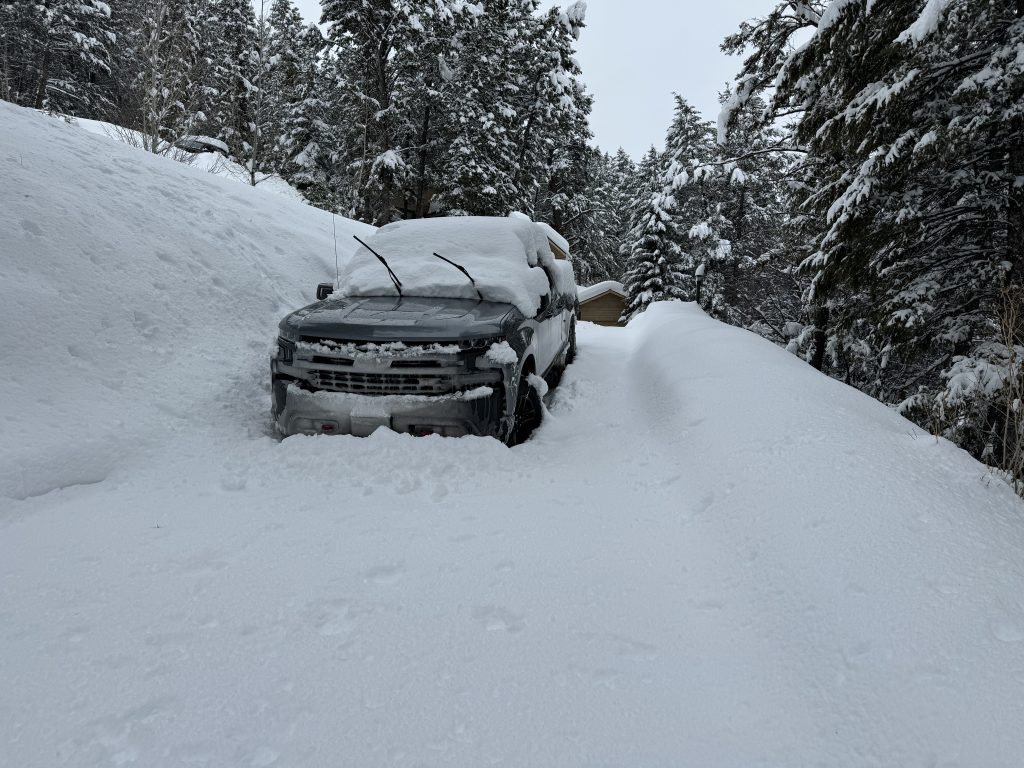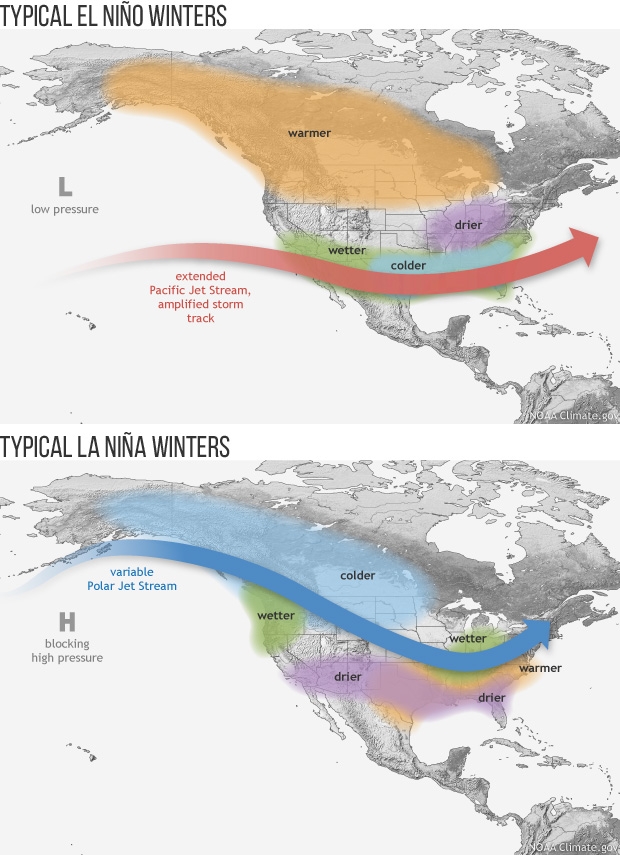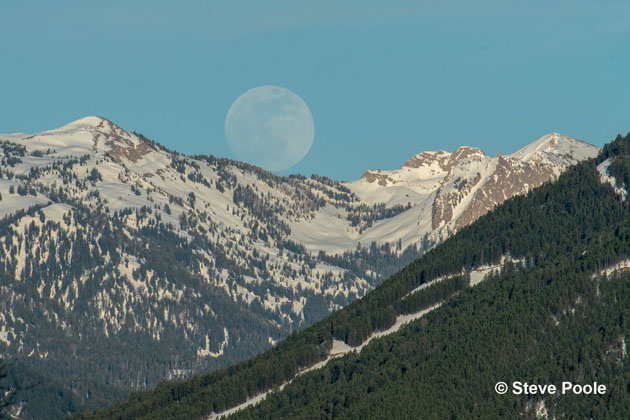
All posts by Jim Woodmencey
Storm Clouds Tetons

Cool Clouds
Springtime in the Tetons
Aurora Borealis
Moonrise over Cache Creek
Snowfall Summary for Winter 2023-24
It was a slow start to the Winter of 2023-24, but a big February and record March snowfall saved our winter. The winter ended with above average snowfall in both the Jackson Hole valley and up in the mountains.
Think back to how grim the winter was looking around here all through December and into the first week of January. The Town of Jackson only had one inch of settled snow on the ground on New Year’s Day. The average snow depth that time of year in town is around 8 inches.

The mountains were also looking skinny, snowpack-wise. The upper elevations at the Jackson Hole Mountain Resort only had 36 inches of snow on the ground on January 1st, 2024. The average depth there on that date is 58 inches. The base of the mountain only had 5 inches of snow on the ground on New Year’s Day, and the historical average there is 22 inches.
 Click here to view video…skiing on Teton Pass 29DEC2023
Click here to view video…skiing on Teton Pass 29DEC2023
Mid-January brought some hope and relief, but it was February and March that piled it on. Read on for a complete review of the winter’s snowfall numbers and how they compared to years past and the averages.
Town Snow
Winter began almost bone dry. Very little snow fell in November and December’s total snowfall in town was less than 6 inches, compared to an average snowfall in December of 17 inches.
A couple of good storms mid-January gave winter a much-needed shot in the arm, ending the month with 21.9 inches of snowfall, which is just above the average January snowfall in town of 19 inches.
February 2024 added another 34.6 inches of snowfall in town, making that the third snowiest February on record in Jackson. Only February of 2019 with 55 inches and February of 1999 with 44 inches had more than this past February.
March came in like a lion and went out like a lion. On March 1st to 2nd, 2024, Jackson broke a 24-hour snowfall record, with 17 inches of accumulation in town. That is the most snow ever recorded in one day during the month of March in Jackson. The previous record was 14 inches on March 25th, 1907.

March continued to roar, ultimately breaking the monthly snowfall record with a total of 33.9 inches. That beat out the old record for March snowfall of 32.8 inches, set back in 1938.
Total Snowfall for the four months of winter, December through March in Jackson was just over 96 inches, 96.2 inches to be exact. That is 157-percent of the average winter snowfall in Jackson of 61 inches. Surprisingly, this winter also bested last winter’s December through March snowfall total in town of 83 inches.

Jackson also measured 7.11 inches of water in that snow. That is 132-percent of the average December through March precipitation amount of 5.39 inches. This winter was also wetter than last winter, the December through March precipitation in 2022-23 was 6.50 inches.

Mountain Snow
Snowfall in the mountains this winter during the “ski-season”, from December 1st to April 1st, ended up above average. The Rendezvous Bowl study plot at around the 9,600-foot elevation at the Jackson Hole Mountain Resort tallied 360 inches for December 2023 through March 2024. That is more than the long-term average of 312 inches for that time period, but nowhere close to the record-breaking snowfall total of the previous winter, which had 443 inches from December through March 2022-23.
It was February and March this year that picked up the slack. February 2024 had 131 inches of snowfall at the Rendezvous Bowl site, making it the 5th snowiest February there in 49 seasons. March of 2024 had 99 inches of snowfall, tying it with March of 2018 for the 7th snowiest March on record.

JHMR also broke their one-day snowfall record on March 1st to 2nd, 2024 at Rendezvous Bowl, with 31 inches of snow recorded at Rendezvous Bowl in a 24-hour period. That blew away the old one-day snowfall record of 26 inches from December 23rd to 24th, 2008.
Snow Summary
Last winter had an earlier start, with snow beginning in November, and basically never letting up, with every winter month seeing above average snowfall. This winter had a later start, with well below average snowfall in November, December and into January. Then in February and March of this year winter finally kicked in, outperforming the previous year.
February and March of 2024 had a combined total snowfall just shy of 69 inches in the Town of Jackson, compared to February and March of 2023 which had 41 inches combined. Both years were well above the long-term average total snowfall for the two months of 25 inches.
In the mountains, Rendezvous Bowl recorded a total of 230 inches of snow this February and March, whereas the combined total snowfall for February and March of 2023 was 211 inches. The average snowfall at that location for February and March combined is 140 inches.
Although it came later, overall, the winter of 2023-24 still ended up a snowier than normal winter, both in town and in the mountains.
Jim is the chief meteorologist at mountainweather.com and has forecast the weather in Jackson Hole for over 30 years.
Note: This post originally appeared in the Jackson Hole news & Guide April 17th, 2024 issue.
Reflections on the Snake

El Nino, La Nina, Whatever
Is there such a thing as a typical El Niño or La Niña?
Every year there is always a lot of talk about El Niño and La Niña and how it might affect the weather, especially our winter snowfall. The terms have become quite commonplace, although I suspect most people don’t fully understand what these terms mean. We just assume that whatever is going on with the weather is because, “It’s an El Nino year”, or “It’s a La Nina year”.
This winter started out warm and dry in Jackson. Blame that on El Niño, right? Then, it started snowing in mid-January, followed by the major dump of snow we just had mid-February. Do we also blame that on El Niño? Well, consider this, we now have a deeper snowpack in town and in the mountains than we had last year at this same time, when it was a La Niña year.
Let’s take a closer look at what defines an El Niño or a La Niña and what other things influence the weather we get from one winter to the next.
ENSO
El Niño and La Niña are part of what is known as the El Niño Southern Oscillation, or ENSO. There are three phases to ENSO that are based on the sea-surface temperatures in the Equatorial Pacific. El Nino is the warm phase, La Nina is the cold phase, and then there is a neutral phase, when sea surface temps are closer to normal, I’ll call that a No Niño. These conditions develop over a period of months and may last from 3 to 12 months, or longer.
ENSO conditions go back & forth between warmer and colder every few years. Some events are stronger, although the majority are weaker events.
Stronger events tend to have more of an impact on the weather patterns across the Northern Pacific Ocean during the winter months and are often loosely correlated with areas of above & below normal snowfall in the Western United States.
El Niño
Our current El Niño began early last fall and is now expected to weaken as we head towards spring, El Niño conditions occur when warmer than normal sea-surface temperatures exist across the Equatorial Pacific. Easterly trade winds on either side of the equator become weaker during an El Niño, which is caused by a weakening pressure gradient between the eastern Pacific & western Pacific (between Peru and Australia). Weaker trade winds allow warmer surface water to surge eastward, replacing the normal cooler water off the coast of South America.Typically, during El Niño winters the Southwestern U.S is cooler & wetter than normal, and the Northwestern U.S. is warmer & drier than normal. In Jackson, historically, El Niño winters have not been our snowiest winters.
La Niña
Last winter, and the previous two winters before that, we were under La Niña conditions. La Niña conditions occur when sea-surface temperatures across the Equatorial Pacific are colder than normal. During a La Niña the Easterly trade winds are stronger, causing cooler water in the eastern Pacific to spread westward, allowing the upwelling of even colder water along off the coast of South America.Typically, during La Niña winters the Northwestern U.S. is cool & snowier than normal, and the Southwestern U.S is warmer & dry.

In Jackson, the majority of our biggest winters, like last winter’s record snowfall in the mountains, came under a La Niña. However, untypically, record snowfalls occurred throughout the Western U.S. The year before that was also a La Niña winter and Jackson had below average snowfall, as did many other areas across the West.
UCLA Study
A recent study by scientists at the University of California, Los Angeles and the California Institute of Technology, found that using ENSO to predict the winter seasonal outlook and the amount of California’s precipitation is unreliable. Their study found that ENSO only plays a minor role for total CA precipitation; instead, a majority of CA precipitation is independent of ENSO and more closely associated with the atmospheric wave patterns that develop over the North Pacific.
The study went on to say, “historical records suggest that ENSO only explains about 30-percent of the year-to-year variability of CA winter precipitation”.
Since long-range winter outlooks rely heavily on the condition of the ENSO, it might be prudent to look beyond just that particular oscillation.
Other Oscillations
Ocean circulations and water temperatures drive our weather. ENSO is just one piece of that bigger puzzle. Stronger storms tend to develop where there are bigger differences in temperature, between the North Pacific Ocean and the Equator, for instance. And also, across the North Pacific, from west to east.
While El Niño and La Niña get all the press, there are other oscillations going on in the oceans that you never hear about, which also affect the weather patterns in the Pacific and around the globe. Such as, the Pacific Decadal Oscillation (PDO), the Pacific North American Pattern (PNA), the North Atlantic Oscillation (NAO), the Arctic Oscillation (AO), the Indian Ocean Dipole (IOD), and the Madden-Julian Oscillation (MJO), to name a few.
Some of these oscillations last several years, some a few days to weeks, but they are all interacting with whatever phase ENSO happens to be in and dictating where storms develop and where they track.
I hope you can now understand that the weather we get depends on more than what is happening with ENSO. The last few winters are good examples of why you don’t want to pin the blame on just one thing. It is the complex coupling of atmospheric and oceanic circulations, and their many oscillations, that ultimately determine the weather we receive. All of that is constantly changing, which is what makes meteorology so fascinating, and challenging.
Posted by meteorologist Jim Woodmencey
Glory Moon






